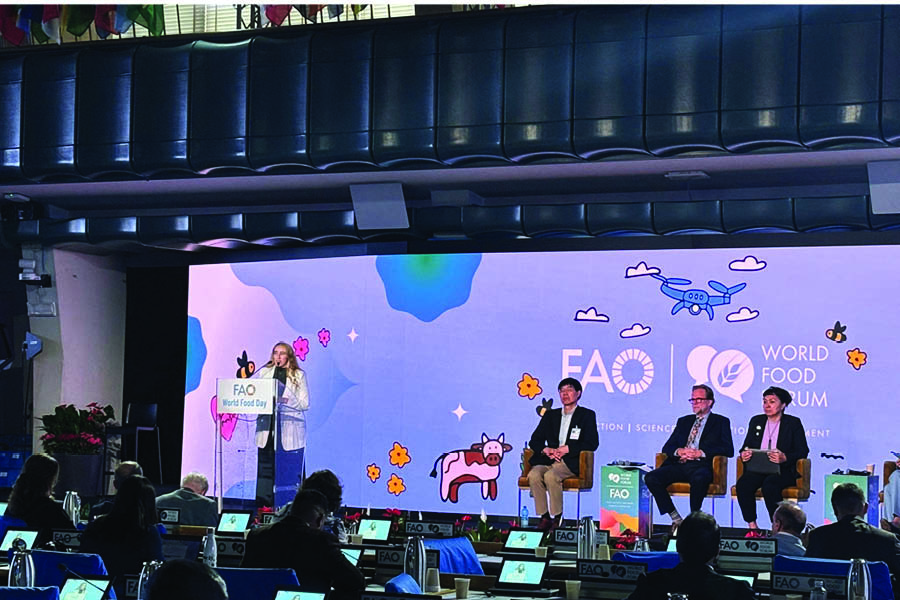We are pleased to present an interview with Ebba Engström, discussing insights from the report, Digital Technologies for Multidimensional Youth Engagement in Agrifood Systems Transformation, from WFF Young Scientists Group. In this conversation, Ebba explores how digital technologies are enabling young people to actively engage in agrifood systems transformation initiatives.
What motivated the Young Scientists Group to explore the role of digital technologies in engaging youth for agrifood systems transformation?
In choosing the focus of our report, we wanted to explore a topic which concerned youth engagement – drawing specifically from experiences and perspectives of young people. Simultaneously, digital technologies have come to play an ever-growing role in the lives of youth, as well as in the context of agrifood systems. This made it particularly relevant to investigate how digital technologies intersects with youth engagement for agrifood systems transformation, and to do so through a multi-dimensional lens. Our report therefore, covers (1) how youth use digital technologies to transform agrifood systems; (2) how youth can develop digital technologies to transform agrifood systems; (3) how digital technologies can attract youth to engage in transformative projects or activities in agrifood systems; and (4) the role digital technologies can play for youth to engage in meaningful decision-making for agrifood systems transformation.
How can digital technologies be leveraged to ensure that youth, particularly in rural and resource-constrained areas, have equal opportunities to engage in agrifood system transformation?
Digital technologies – even relatively simple information communication technologies- can provide a means for effective communication, information access, and data analysis. These allow for youth to not only engage in activities which help transform their local and regional agrifood systems, but also partake in conversations and decision-making processes at higher levels. However, to promote the use of this digital technologies, essential infrastructure which provide connectivity and electricity must be in place. Addionally, youth need access to training to more effectively use these digital technologies.
What strategies can be implemented to bridge the digital divide and provide youth —particularly those lacking digital access or excluded from development programmes— with the necessary skills and infrastructure to effectively use digital tools in agrifood systems?
One key aspect is the extension of digital infrastructure – to ensure connectivity and provide youth with appropriate means to power or charge their digital tools. Secondly, digital technologies are not always affordable to all – meaning efforts may be needed to financially subsidise these tools on local markets, but also to develop these technologies, so that they can be sold at lower price points. Thirdly, it is essential to implement education and training programmes for the effective use of digital technologies, which are made widely accessible to youth from diverse demographic backgrounds, including women and other minority groups. Moreover, these education and training initiatives should be guided by long-term development strategies and remain adaptive toward continuous digital technological developments.
In your experience, how does the adoption of digital technologies in agrifood systems vary across different regions or contexts?
I think they can vary quite drastically depending on the socioeconomic realities of those who farm or who own a given farming business. That said, the rapid development of certain technologies, along with their decreasing costs, have allowed persons engaged in agrifood systems to leapfrog , i.e. to adopt more developed versions of a technology without first having to adopt its more intermediate versions, especially in relation to communications technologies. Furthermore, it is important to recognise that not all digital technologies may be applicable to all agricultural systems (e.g. given the size of the farmland or the scale of the farming business). On an individual level, farmers’ risk perceptions also play a crucial role – shaping how they weigh potential benefits against the potential downsides from the adoption of digital technologies.
What steps should be taken to translate digital participation into real influence over agrifood policies and practices?
Digital participation already plays a role in how people make choices related to agrifood products and practices. For example, as consumers, our decisions can be influenced by the content we are exposed to via social media channels. Likewise, for those more directly involved in agri-food systems employment, internet-based platforms and communication tools have provided opportunities for engagement with applicable information, communication forums, and market spaces – helping shape their practices. However, in regard to shifting behaviours and activities to support a more sustainable agrifood systems transformation, a key challenge lies in reaching broader audiences who ‘digitally participate’. Furthermore, while actors may have access to information, forums, or marketplaces through digital technologies with internet access, this does not necessarily lead to more sustainable decision-making.
Therefore, for individuals or groups aiming to promote agrifood systems transformation through policy and practice, several efforts are needed. First, they must find effective ways to reach different demographics who participate in digital spaces. Secondly, it is crucial to consider how to interact with these audiences to prompt and motivate them to act more sustainably and support relevant policies. Thirdly, these individuals or groups need to have insight into the discussions potentially happening in relevant online forums and the way online marketplaces operate to better influence behaviour and to share this understanding with policy-makers for evidence-based decision-making. Fourthly, strategies and guidelines must be introduced to bring the discussions from digital platforms into policymaking arenas – and mechanisms for evaluating the impacts assessments of these efforts must be established.
Could you share examples of global food systems discussions that have utilized digital technologies for agrifood transformation? How can these be scaled up to increase their impact globally?
A couple of examples of global agrifood systems discussions or campaigns which have utilised digital technologies to promote agrifood systems transformation are the UN Food Systems Summit (UNFSS) and Act4Food. The UNFSS was centred around its digital platform that helped raise awareness of the initiatives taking place prior to the official summit in 2021. Many of the regional and national meetings which contributed to the UNFSS were held online. Act4Food makes use of its digital website platform to both reach youth wanting to engage in agrifood systems transformation and decision-makers – and they are also active on social media platforms. I believe to increase the impact globally of these types of digitally driven discussions and campaigns there is a need to better understand the impacts they are having on agrifood systems practices and policy – including through their ‘digital presence’. This may require quite complex and broad-scale impact assessments. During UNFSS, there were questions of how discussions (including those held online) at regional and national levels were feeding into the UNFSS and the goals set by different countries who took part. In better understanding these impacts, the initiatives can be better developed and scaled, including via their digital platforms.
Given that youth are already utilizing digital technologies for networking and advocacy, what policies/practices should be implemented to ensure these tools are also used to provide tangible career and business opportunities within agrifood systems?
I believe one important aspect is reaching youth through digital means to showcase available opportunities – but to also showcase the skillsets required for different jobs within this field. More so, it’s about reaching a broader range of youth – which then requires having effective communication strategies. However, I believe that this information access is only a small part of the puzzle – there is a need to ensure that youth have access to financial and social resources to support the development of businesses and careers within the agrifood sector. Beyond technical skills, training should also cover the regulatory and market environment which youth will need to navigate. Additionally, the skillset needs may vary drastically between youth who come from families with a history of e.g. farming – who have access to intergenerational knowledge and associated social capital, and those who do not. This disparity must be kept in mind when designing training and educational programmes.

